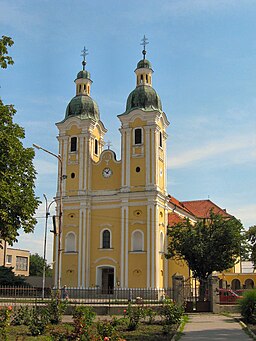Šurany
| Šurany Nagysurány |
|||
| Town | |||
|
Church of St. Stephen the protomartyr
|
|||
|
|||
| Country | Slovakia | ||
|---|---|---|---|
| Region | Nitra | ||
| District | Nové Zámky | ||
| River | Nitra | ||
| Elevation | 123 m (404 ft) | ||
| Coordinates | 48°05′14″N 18°11′10″E / 48.08722°N 18.18611°ECoordinates: 48°05′14″N 18°11′10″E / 48.08722°N 18.18611°E | ||
| Area | 59.812 km2 (23 sq mi) | ||
| Population | 10,460 (31 December 2006) | ||
| Density | 175/km2 (453/sq mi) | ||
| First mentioned | 1138 | ||
| Mayor | Marek Oremus | ||
| Timezone | CET (UTC+1) | ||
| - summer (DST) | CEST (UTC+2) | ||
| Postal code | 942 01 | ||
| Phone prefix | 421-35 | ||
| Car plate | NZ | ||
| Statistics: MOŠ/MIS | |||
| Website: http://www.surany.sk | |||
Šurany (until 1927, Veľké Šurany; Hungarian: Nagysurány; German: Schuran; Turkish: Şuran) is a town and a railroad hub in the Nové Zámky District, Nitra Region, southern Slovakia.
Alongside the main settlement, it has the boroughs of Kostolný Sek and Nitriansky Hrádok, both annexed 1976.
Archaeological discoveries show that the site of the present-day town was inhabited in the Neolithic. The town was first mentioned under name villa Suran in a document of Hungarian king Béla II in 1138. There was a castle existing since the second half of the 15th century. Between 1568 and 1581, the town was the seat of the Captaincy of Lower Hungary. The settlement was occupied by the Turks in 1663–84. The castle was torn down in 1725. In 1832 the town was made a royal town with market rights. A sugar factory was established in 1854 (closed in 2000). The town was part of Hungary until 1920 and in 1938–45 as a consequence of the First Vienna Award.
Šurany lies at an altitude of 123 metres (404 ft) above sea level and covers an area of 59.812 square kilometres (23.1 sq mi). It is located in the Danubian Lowland near the Nitra River, 13 kilometres (8 mi) away from Nové Zámky and around 100 kilometres (62 mi) from Bratislava.
According to the 2001 census, the town had 10,491 inhabitants. 97.28% of inhabitants were Slovaks, 1.12% Hungarians, 0.64% Czechs. The religious make-up was 80.02% Roman Catholics, 14.76% people with no religious affiliation, and 1.19% Lutherans.
...
Wikipedia







